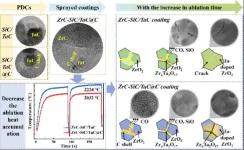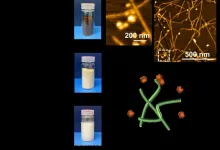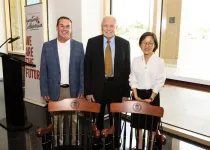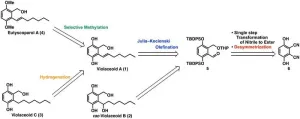Retrotransposon DNA zip code for myeloma cell internalization
“GT is a fascinating evolutionary phenomenon observed in lower species and humans, albeit with differing impacts and mechanisms”
2024-08-09
(Press-News.org)
“GT is a fascinating evolutionary phenomenon observed in lower species and humans, albeit with differing impacts and mechanisms.”
BUFFALO, NY- August 9, 2024 – A new editorial was published in Oncoscience (Volume 11) on July 13, 2024, entitled, “Unveiling retrotransposon-derived DNA zip code for myeloma cell internalization.”
The complex interplay between extracellular genetic material and the tumor's genetic landscape presents a significant challenge in grasping cancer evolution, tumor genetic heterogeneity, and treatment response. Earlier research has revealed the role of circulating tumor DNA (ctDNA) in mediating the gene expression among cancer cells, offering new insights into a previously under-explored aspect of genetic exchange in human malignancies.
In this editorial, researchers Pavan Kumar Puvvula, Anthony Johnson, and Leon Bernal-Mizrachi from Kodikaz Therapeutic Solutions, Inc. and Winship Cancer Institute of Emory University delve into the findings of several studies that elucidate the mechanisms underlying ctDNA-driven gene transfer (GT) and its potential implications for cancer biology and therapy.
“GT is a fascinating evolutionary phenomenon observed in lower species and humans, albeit with differing impacts and mechanisms.”
This research highlights the importance of retrotransposon-derived DNA zip codes in myeloma cell biology and their interactions with the tumor microenvironment.
“Collaboration between academia, industry, and regulatory agencies will be essential for translating zip-code technology from the bench to the bedside and realizing its full potential in improving patient outcomes and advancing human health.”
Continue reading: DOI: https://doi.org/10.18632/oncoscience.606
Corresponding authors - Pavan Kumar Puvvula - pavan@kodikaz.com, and Leon Bernal-Mizrachi - lbernal@emory.edu
Keywords: cancer, myeloma, non-viral gene therapy, retrotransposons, Rab5a, Clathrin, Syntaxin-6, DNA internalization, Zip-code
About Oncoscience:
Oncoscience is a peer-reviewed, open-access, traditional journal covering the rapidly growing field of cancer research, especially emergent topics not currently covered by other journals. This journal has a special mission: Freeing oncology from publication cost. It is free for the readers and the authors.
To learn more about Oncoscience, visit Oncoscience.us and connect with us on social media:
X
Instagram
Facebook
YouTube
LinkedIn
For media inquiries, please contact media@impactjournals.com.
Oncoscience Journal Office
6666 East Quaker St., Suite 1
Orchard Park, NY 14127
Phone: 1-800-922-0957, option 4
END
[Attachments] See images for this press release:
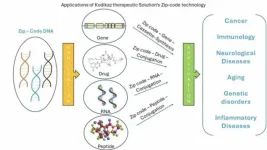
ELSE PRESS RELEASES FROM THIS DATE:
2024-08-09
ZrC has drawn wide attention as an anti-ablation coating material for lightweight C/C composites but is limited by the produced porous and loose ZrO2 film. To address this issue, the second phase is introduced to improve the densification of the formed Zr-X-O film. Such as ZrC-SiC/TaC coating, the produced low-melting-point oxides, SiO2 (Tm=1650 °C), Ta2O5 (Tm=1800 °C) and Zr6Ta2O17 (Tm=1900 °C), helped to form a dense oxides film. However, the high service temperature causes heat accumulation and a large thermal stress gradient on the surface of the coatings, which will result in large local defects and accelerate the failure of the coating. To decrease the ablation heat ...
2024-08-09
Fukuoka, Japan—The SDGs Design International Awards 2024 are calling for students worldwide to submit their original ideas for using design to achieve Sustainable Development Goals.
First organized in 2019 and led by Faculty of Design, Kyushu University, the awards aim to demonstrate the power of design in solving social problems and to elevate society's expectations for design.
Now in its sixth year, this year’s theme is “Let’s Create Sustainable Design for FOOD." ...
2024-08-09
Along with all the coffee we drink every day, over 6 million tons of spent coffee grounds are produced annually worldwide. Some of these grounds are reused as biofuel but the rest are disposed of in landfills. Over the last decade, research has focused on how to reuse these grounds. The primary focus has been on the polysaccharides from the cellulose and hemicellulose in the ground up coffee bean’s cell walls. Polysaccharides are used in composites, biopolymers, food packaging, construction materials and cellulose nanofibers (CNFs). CNFs specifically, which are cellulose reduced to nanoparticle size, 3 to 5 ...
2024-08-09
As the effects of a changing climate and other ecological insults compound, many coral reefs face severe perturbations and a generally poor prognosis for recovery. In an article published in BioScience's new "Perspective and Insight" category, Dr. Peter J. Edmunds of California State University, Northridge, argues for the continued monitoring of coral reefs, even when the seascapes they inhabit are in a significantly degraded state.
Drawing from his ongoing 37-year study in the US Virgin Islands, Edmunds argues that "only consistent, rigorous, and detail-oriented ...
2024-08-09
Rockville, MD (8/9/2024) – The AIM-HI Accelerator Fund today announces Margaret Foti, PhD, MD (hc), Chief Executive Officer of the American Association for Cancer Research (AACR), is selected unanimously by the 2024 Blue Ribbon Selection Committee as the recipient of the 2024 Beacon Award for Women Leaders in Oncology, from a pool of outstanding global nominees.
The Beacon Award for Women Leaders in Oncology was established in 2022 by the AIM-HI Accelerator Fund and sponsored by the National Foundation for Cancer Research (NFCR). The Beacon Award recognizes outstanding women leaders in health and life sciences who have significantly impacted cancer ...
2024-08-09
In a July 9 ceremony, Thomas Abbruscato, Ph.D., and Min Kang, Pharm.D., became the first recipients of the Douglas Stocco Research Chair, an endowment formerly known as the Texas Tech University Health Sciences Center’s (TTUHSC) Research Endowment. The Texas Tech University System Board of Regents officially renamed the endowed chair in late November 2023 and made two appointments available.
Abbruscato, professor and chair in the Department of Pharmaceutical Sciences at the TTUHSC Jerry H. Hodge School of Pharmacy, said it is an honor to receive the endowment.
“Personally, I am humbled to have ...
2024-08-09
The natural world is rich in chemical compounds with remarkable medicinal properties. A notable example is penicillin, discovered by chance from the Penicillium mold. This discovery revolutionized the treatment of bacterial infections and highlighted the potential of natural compounds in medicine. Since then, the identification, isolation, and synthesis of novel bioactive compounds from plants, fungi, and bacteria have become fundamental to drug development.
Recently, two groups of naturally occurring bioactive compounds have garnered significant attention: violaceoids A–F ...
2024-08-09
New research from the University of Adelaide has shown that glossy black-cockatoos prefer to feed from trees growing in acidic soils.
Glossy black-cockatoos are seed-eating birds that feed almost exclusively on the cones of drooping sheoak trees. However, counterintuitively, they select trees that grow on the poorest soils found on ancient sedimentary rocks.
“Sheoak trees are three times more likely to be used as feeding trees if they are growing on non-limestone sedimentary rocks,” says Dr Gay Crowley, from the University of Adelaide’s School of Social Sciences.
Dr Crowley compared 6,543 feeding records with 23,484 ...
2024-08-09
Autistic youth who were born in underserved neighborhoods are more likely to have greater attention deficit hyperactivity disorder (ADHD) symptoms than those born in communities with more resources. This is one finding of a new study led by researchers at the UC Davis MIND Institute.
This is the first time researchers have investigated how neighborhood factors are associated with ADHD in autistic and non-autistic children. The study provides new insights into mental health conditions and has the potential to inform public policy changes to improve health equity.
It was published in the journal JCPP Advances.
“We found that some neighborhood ...
2024-08-09
Content warning: This post contains details of sharing intimate imagery without consent that may be disturbing to some readers.
While much attention on sexually explicit “deepfakes” has focused on celebrities, these non-consensual sexual images and videos generated with artificial intelligence harm people both in and out of the limelight. As text-to-image AI models grow more sophisticated and easier to use, the volume of such content is only increasing. The escalating problem led Google to announce last week that it will work to filter out these deepfakes in search results, and the Senate recently passed ...
LAST 30 PRESS RELEASES:
[Press-News.org] Retrotransposon DNA zip code for myeloma cell internalization
“GT is a fascinating evolutionary phenomenon observed in lower species and humans, albeit with differing impacts and mechanisms”

